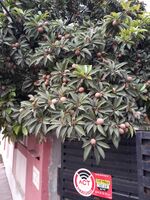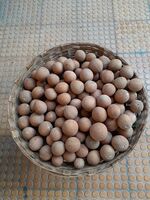Chiku
| Author:Laxman Burdak, IFS (R) |
Chiku or Manilkara zapota is a long-lived, evergreen tree native to southern Mexico, Central America and the Caribbean.
Variants
- Chiku/Chicoo (चीकू)
- Sapota (सपोटा)
- Manilkara zapota (Botanical name)
- Sapodilla
- Sapote
- Chicozapote
- Chicle
- Naseberry
- Nispero
Origin of name
The specific epithet zapota is from the Spanish zapote [saˈpote], which ultimately derives from the Nahuatl word tzapotl.
Most of the common names of Manilkara zapota like "sapodilla" and "chicozapote" come from Spanish meaning "little sapote".[1]
Other common names in English for Manilkara zapota include bully tree, sawo, and marmalade plum.[2]
Description
Sapodilla can grow to more than 30 m (98 ft) tall with a trunk diameter of up to 1.5 m (5 ft). The average height of cultivated specimens, however, is usually between 9 and 15 m (30 and 49 ft) with a trunk diameter not exceeding 50 cm (20 in).[3] It is wind-resistant and the bark is rich in a white, gummy latex called chicle. The ornamental leaves are medium green and glossy. They are alternate, elliptic to ovate, 7–15 cm (3–6 in) long, with an entire margin. The white flowers are inconspicuous and bell-like, with a six-lobed corolla. An unripe fruit has a firm outer skin and when picked, releases white chicle from its stem. A fully ripened fruit has saggy skin and does not release chicle when picked.
The fruit is a large berry, 4–8 cm (2–3 in) in diameter.[4] Inside, its flesh ranges from a pale yellow to an earthy brown color with a grainy texture akin to that of a well-ripened pear. Each fruit contains one to six seeds.[5] The seeds are hard, glossy, and black, resembling beans, with a hook at one end that can catch in the throat if swallowed.
The fruit has an exceptionally sweet, malty flavor. The unripe fruit is hard to the touch and contains high amounts of saponin, which has astringent properties similar to tannin, drying out the mouth.
The trees can survive only in warm, typically tropical environments, dying easily if the temperature drops below freezing. From germination, the sapodilla tree will usually take anywhere from five to eight years to bear fruit. The sapodilla trees yield fruit twice a year, though flowering may continue year round.[6]
Distribution
An example natural occurrence is in coastal Yucatán (Mexico) in the Petenes mangroves ecoregion, where it is a subdominant plant species.[7] It was introduced to the Philippines during Spanish colonization. It is grown in large quantities in Mexico and in tropical Asia including India, Pakistan, Thailand, Malaysia, Cambodia, Indonesia, Vietnam, Bangladesh.
Uses
Compounds extracted from the leaves showed anti-diabetic, antioxidant and hypocholesterolemic (cholesterol-lowering) effects in rats.[8]
Acetone extracts of the seeds exhibited in vitro antibacterial effects against strains of Pseudomonas oleovorans and Vibrio cholerae.[9]
The fruit is edible and a favorite in the tropical Americas.[10]
Chicle from the bark is used to make chewing gum.
चीकू पेड़ की उपयोगिता
चीकू पेड़ की उपयोगिता: चीकू पेड़ के पर्यावरणीय महत्व और पक्षियों के लिए इसकी उपयोगिता के बारे में हम जानते हैं. वर्तमान लेख में चीकू के पेड़ का विज्ञान और इसकी उपयोगिता पर चर्चा की जावेगी. जयपुर में मेरे घर में एक ही चीकू का पेड़ है परंतु इसने कोरोना काल में फलों की पूरी मांग-पूर्ति हमारे लिए की. बाहर से तरबूज के अलावा कोई फल नहीं खरीदा गया. शहरों में घर पर लगाने के लिए यह सबसे अच्छा फलदार वृक्ष है क्योंकि चीकू के कच्चे फल को न तो कोई जीव खा सकता है और न कोई आदमी. घर में चीकू के प्रबंधन के लिए अंतिम पैरा अवश्य पढ़ें.
मैंने यह देखा है कि शहरों में आजकल चीकू के पेड़ घरों में लगा रखे हैं परंतु इसके फलों के पकाने और प्रयोग करने की जानकारी नहीं होने के कारण कच्चे तोड़ दिए जाते हैं. कच्चे फलों में लेटेक्स होने के कारण यह खाने के लिए उपयोगी नहीं होते हैं. बंदर भी गलती से कच्चा फल तोड़कर खाने लगता है तो मुँह में दूध चिपकने के कारण नहीं खाता. बहुत लोग कहते हैं कि हमने तो घर पर चीकू का पेड़ गलत लगा लिया. हमारे यहाँ तो चीकू के फल पकते ही नहीं हैं. इस भ्रम को दूर करने और चीकू के फल का सही उपयोग करने के लिए यह लेख दे रहा हूं.
चीकू का विज्ञान: चीकू वृक्ष का वानस्पतिक नाम : Manilkara zapota है. चीकू (Chiku) या सपोटा (Sapota) सैपोटेसी कुल का पौधा है जो भारत में अमेरिका के उष्णकटिबंधीय भाग से लाया गया था. चीकू मुख्य रूप से तीन प्रकार के होते हैं: 1. लम्बा गोल, 2. साधारण लम्बा गोल, 3. गोल. चीकू का पेड़ 3-4 साल बाद फल देने लग जाता है. यह वर्ष में 2 बार फल देता है. जो फल गर्मी में तैयार होते हैं वह अधिक मीठे होते हैं.
चीकू फल के लाभ
चीकू में विटामिन ए, ग्लूकोस, टैनिन जैसे तत्व पाए जाते हैं जो कब्ज, एनीमिया, तनाव, बवासीर और जख्म को ठीक करने के लिए सहायक होते हैं. चीकू में कुछ खास तत्व पाए जाते हैं जो श्वसन तंत्र से कफ और बलगम निकालकर पुरानी खांसी में राहत देता है. चीकू फल के उपरोक्त गुणों को देखते हुये मेरा अनुमान है कि कोरोना के बचाव में भी यह एक उपयोगी फल है. कोरोना पर इसके प्रभाव के संबंध में यद्यपि कोई अध्ययन उपलब्ध नहीं है.
चीकू का प्रयोग खाने के साथ जैम, शेक, आइसक्रीम आदि बनाने में भी किया जाता है. चीकू में लेटेक्स (दूध) अच्छी मात्र में पाया जाता है जो दांत की कैविटी को भरने के लिए भी इस्तेमाल किया जाता है. चीकू की खेती फलोत्पादन तथा लैटेक्स उत्पादन के लिए की जाती है. चीकू के लेटेक्स का उपयोग चुइंगम तैयार करने के लिए भी किया जाता है.
चीकू का पेड़ लगाने के लिए सबसे अच्छा समय वर्षा ऋतु है. चीकू के पौधे को शुरुआत में दो-तीन साल तक विशेष रखरखाव की जरूरत होती है. इसके बाद वर्षों तक इसकी फसल मिलती रहती है. इसमें साल में दो बार फल आता है. पहला फरवरी से जून तक और दूसरा सितंबर से अक्टूबर तक. फूल लगने से लेकर फल पक कर तैयार होने में लगभग 4 महीने लग जाते हैं.
चीकू वृक्ष का वितरण
चीकू वृक्ष का वितरण: भारत के गुजरात, महाराष्ट्र, कर्नाटक तथा तमिलनाडु राज्यों में इसकी बड़े क्षेत्र में खेती की जाती है. इस के लिए बहुत ज्यादा सिंचाई और अन्य रखरखाव की जरूरत नहीं है. कम पानी से भी इसके पेड़ फलने-फूलने लगते हैं.
चीकू के फलों की तुड़ाई
चीकू के फलों की तुड़ाई: व्यावसायिक रूप में इसके फलों की तुड़ाई प्राय: जुलाई से सितंबर महीने में की जाती है. किसानों को एक बात का ध्यान रखना चाहिए कि अनपके फलों की तुड़ाई ना करें. तुड़ाई मुख्यत: फलों के हल्के संतरे या आलू रंग के होने पर जब फलों में कम चिपचिपा दूधिया रंग हो तब की जावे. इस समय फल तोड़ना आसान होता है.
घर में चीकू का प्रबंधन
शहरों में आजकल चीकू के पेड़ घरों में लगा रखे हैं परंतु इसके फलों के पकाने और प्रयोग करने की जानकारी नहीं होने के कारण फल कच्चे तोड़ दिए जाते हैं. कच्चे फलों में लेटेक्स (चिप-चिपा दूध) होने के कारण यह खाने के लिए उपयोगी नहीं होते हैं. हम घर पर लगे चीकू के फल का प्रयोग मई के प्रथम सप्ताह से लगातार कर रहे हैं. एक ही पेड़ में 1.50 क्विंटल के लगभग उत्पादन हो चुका है. इसका पता कैसे चले कि कौनसा फल पकने वाला है. पकने पर फल का रंग हल्का भूरा या हल्के संतरे या आलू के रंग जैसा होने लगता है. जब फल पकने वाला होता है तो पक्षी इसको खाने का प्रयास करते हैं और एक-आध फल नीचे गिरा दिखाई देगा. तब समझो कि फल अब पकने वाले हैं. तुड़ाई का प्रबंधन इस तरह से करें कि 4-5 दिन की आवश्यकता के फल पकने से ठीक पहले तोडलें. इनको अख़बार में लपेट कर टोकरी में अच्छी तरह से ढ़क दें. 2-3 दिन के बाद देखें. इनमें से कुछ फल पक गए हैं. पके फल हाथ से छूने पर बहुत नरम चमड़े जैसे आभास देते हैं. इनको निकाल कर फ्रिज में सूती कपड़े से लपेट कर रखदें. सूती कपड़े से लपेटने पर इनका रंग नेचुरल बना रहता है. इस तरह आवश्यकता अनुसार धीरे-धीरे तोड़कर पकाते रहें, छिलकर खाते रहें और मित्रों को भी देते रहें.
External links
References
- ↑ Small, Ernest. Top 100 Exotic Food Plants. CRC Press. p. 515. ISBN 9781439856888.
- ↑ "Manilkara zapota". European and Mediterranean Plant Protection Organization (EPPO).
- ↑ Manilkara zapota Sapotaceae (L.) van Royen, Orwa C, Mutua A, Kindt R, Jamnadass R, Simons A. 2009. Agroforestree Database:a tree reference and selection guide version 4.0 (http://www.worldagroforestry.org/af/treedb/)
- ↑ Harris, Kate (2009). Trees of Belize. Belize: Bay Cedar Publishing. pp. 94–95. ISBN 9780992758202.
- ↑ Kute, L.S.; Shete, M.B. (1995). "Sapota (Sapodilla)". Handbook of Fruit Science and Technology. CRC Press. pp. 475–476.
- ↑ Kute, L.S.; Shete, M.B. (1995). "Sapota (Sapodilla)". Handbook of Fruit Science and Technology. CRC Press. pp. 475–476.
- ↑ World Wildlife Fund. eds. Mark McGinley, C.Michael Hogan & C. Cleveland. 2010. Petenes mangroves. Encyclopedia of Earth. National Council for Science and the Environment. Washington DC
- ↑ Fayek NM, Monem AR, Mossa MY, Meselhy MR, Shazly AH (2012). "Chemical and biological study of Manilkara zapota (L.) Van Royen leaves (Sapotaceae) cultivated in Egypt". Pharmacognosy Research. 4 (2): 85–91. doi:10.4103/0974-8490.94723. PMC 3326762. PMID 22518080.
- ↑ Kothari V, Seshadri S (2010). "In vitro antibacterial activity in seed extracts of Manilkara zapota, Anona squamosa, and Tamarindus indica". Biol. Res. 43 (2): 165–8. doi:10.4067/S0716-97602010000200003. PMID 21031260.
- ↑ Hargreaves, Dorothy; Hargreaves, Bob (1964). Tropical Trees of Hawaii. Kailua, Hawaii: Hargreaves. p. 14.

